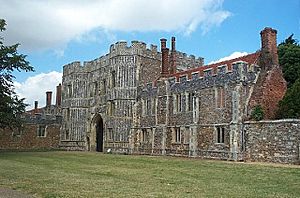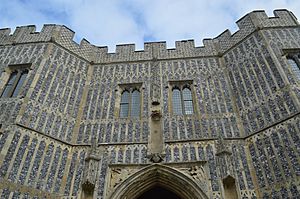St Osyth's Priory facts for kids
St Osyth's Abbey, also known as St Osyth's Priory, was a special kind of religious house in Essex, England. It was home to a group of Christian priests called Augustinian canons. These canons lived and worked there from the 1100s to the 1500s.
The priory was started around 1121 by Richard de Belmeis, who was the Bishop of London. It grew to be one of the biggest religious places in Essex. It was named after Saints Peter and Paul, and also St Osyth. St Osyth was a royal saint and a martyr, meaning she died for her beliefs. Bishop Richard even brought one of St Osyth's arm bones to the church there.
Contents
How St Osyth's Began
The religious house first started as a priory. It was likely home to canons from another priory called Holy Trinity in Aldgate. The very first leader, or prior, of St Osyth's was William de Corbeil. He later became the archbishop of Canterbury in 1123 and even crowned King Stephen in 1135. In the mid-1100s, the priory became an abbey, which is a larger and more important type of religious house.
Learning and Life at the Abbey
In the 1100s, a writer named William of Malmesbury wrote about how good and smart the canons at St Osyth's were. One of the canons, William de Vere, later became a bishop. He wrote a book about the life of St Osyth. He mentioned that his mother, Adeliza, lived at the abbey for twenty years after her husband died.
King Henry II also gave the canons special rights. In the late 1100s, he confirmed that they could choose their own abbot (the head of the abbey). He also said they could hold a market every Sunday in the nearby village of Chich.
The Abbey's End
The abbey was closed down in 1539 by King Henry VIII. This happened during a time called the Dissolution of the Monasteries, when many religious houses in England were closed. At that time, there was one prior and sixteen canons living there.
King Henry VIII first gave the abbey and its lands to his important minister, Thomas Cromwell. But when Cromwell lost the king's favor, the abbey went back to the king. Later, during the time of King Edward VI, the abbey was sold to Sir Thomas Darcy.
What Remains Today
The most important part of the original abbey that is still standing is the gatehouse. It was built in the late 1400s. The outside of the gatehouse shows amazing decorative work made from flint. This gatehouse was even used as a filming location for a TV show in 2003.
Today, five different parts of the old priory are considered Grade I listed buildings. This means they are very important historical buildings.
Images for kids





